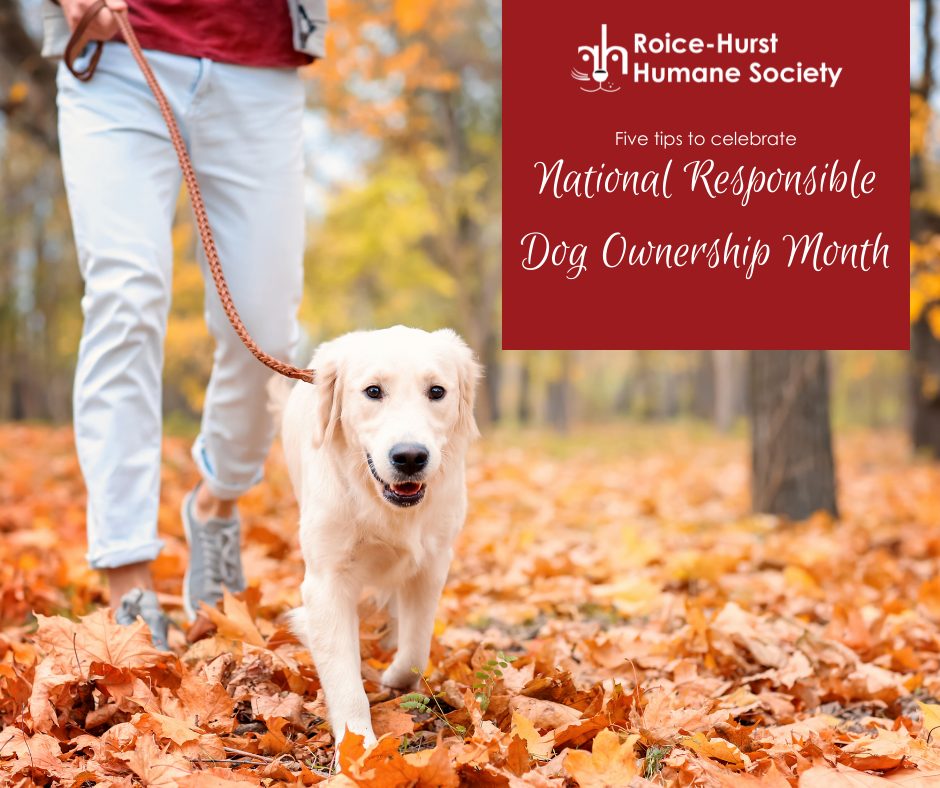September is well-known for its warm colors, changing of seasons, and the beginning of all the wonderful things fall has to offer. Did you also know that September is National Responsible Dog Ownership Month? Taking responsibility for your dog and discovering new ways to grow as a dog owner can strengthen the bond between you and your dog. Whether you are a current dog owner or considering adopting a new canine companion, learning about responsible dog ownership can help set you and your pup up for success. Not sure where to start? Here are five tips to celebrate Responsible Dog Ownership Month and get you and your dog started on the right paw!
1. ID your dog. One of the most important things you can do for your dog as a pet owner is proper identification. Microchips are an excellent choice for pet ID as they are the most permanent form of pet identification. Collars with tags are another great option for pet ID, but it is important to remember to always ensure your dog has his collar on — even at home. Why does a dog need a collar with tags on at home? Accidents happen and we never know when our pet could get lost. Doors and gates could be accidentally left open, fences might get broken, or bored dogs might find a way to go for their own adventures while you are at work. Microchips and keeping a collar with tags on at all times increases the likelihood of reuniting with your pet should they get lost. With all forms of pet identification, always keep your contact information up to date and be sure your microchip is registered to you. If you are interested in microchipping your pet, click here to learn more about RHHS microchip and low-cost vaccination clinics.
2. Find a veterinary clinic you like and stick with it. Choosing a primary clinic for your dog can sometimes be overlooked, but it is important. Research clinics and veterinarians in your area and find one that you would like to establish as your dog’s primary veterinarian. Once you’ve chosen a clinic, don’t wait until your pup is sick to schedule a visit. Annual wellness visits create an ongoing health history and can help detect and track changes in your dog’s health before they become more serious or life-threatening. A healthy pet is a happy pet, so don’t skip out on their health! Keeping your pup up-to-date on vaccinations, spaying or neutering, and prompt treatment of health issues are all great ways to show responsibility for your dog’s health. For more information about how to choose a veterinarian, check out the AVMA’s guide.
3. Get your dog on a schedule. With the change of seasons, it isn’t uncommon for there to be a change in your schedule. These changes can include school starting back up, cooler weather, changes in daylight, and more. To help you and your dog better adjust to the changes fall brings, schedules can be a big help. Setting up a schedule for your dog’s meal times, potty breaks, grooming, training, and exercise needs can make your day — and your dog’s — easier to track. Most dogs enjoy having a routine, and having some time set aside specifically for your dog will ensure your pup is getting adequate care throughout the week instead of wondering, “Did anyone feed Fido today?”
4. Get to know your dog. While it is easy to think, “if this dog likes it, surely my dog will,” it is better to get to know what your dog likes. From toys, treats, and food to types of exercise and enrichment activities, all dogs are different. Maybe you have one dog who lives to play fetch and hates car rides, but your other dog has no interest in playing fetch and prefers cruising around town with the windows down. Maybe your dog likes to swim more than he likes to go for walks, but he has no way of telling you that. Maybe all the noise of the cars and distractions stresses your dog while walking the neighborhood, but going for a hike in nature is what he lives for. Dogs are all different because they are all individuals. What one dog likes, another might not. Get to know your dog and his or her individuality. When you take the time to understand your dog and ensure their needs are being met, it tends to strengthen your bond and creates more happiness. Find what your dog loves and they’ll love you even more for it!
5. Keep your dog safe. A great way to demonstrate responsible dog ownership is by doing things that keep your pet safe. By taking a moment to consider your dog’s safety each day, you will continually be growing as a responsible dog owner. Before going on a hike, check to see if you packed everything your dog needs to safely enjoy the hike. Check the weather and make sure the ground isn’t going to be too hot or too cold for your dog’s paws. Have a pet first aid kit handy for emergencies and develop an emergency plan in case of a disaster. Keeping your dog safe can even be as simple as keeping him on a leash when not in fenced areas or ensuring collars and harnesses are properly fitted. There are many things you can do to help keep your dog safe, including proper restraint or containment while traveling, dog-proofing your home, and protecting them from external parasites like fleas and ticks. Providing the best care for your dog and keeping them safe is something all responsible dog owners strive for, and it goes without saying that your dog appreciates your efforts!
These are just a few of the many ways to practice responsible pet ownership. For more ideas, check out the American Veterinary Medical Association’s Guidelines and Resources on pet ownership.

